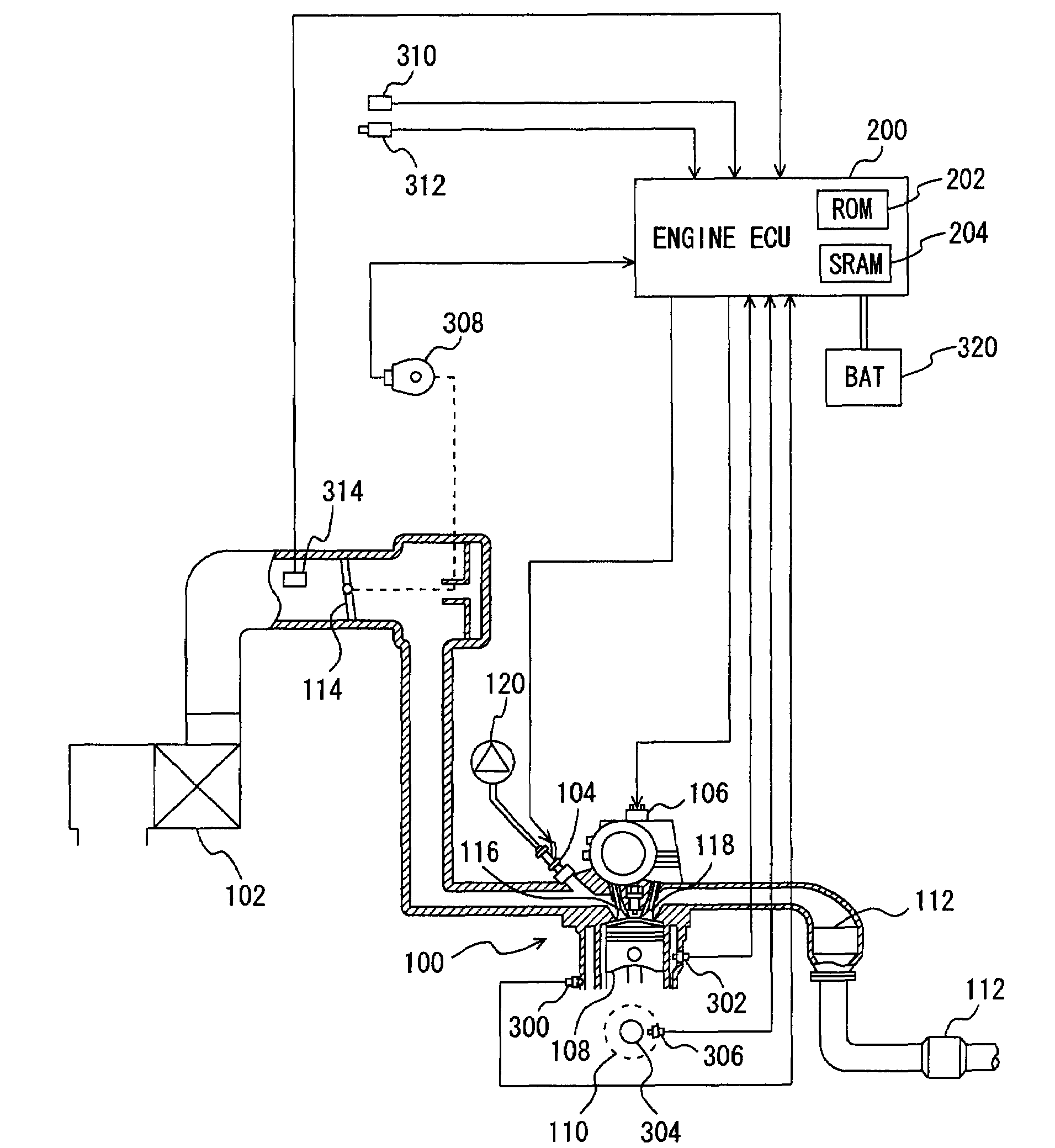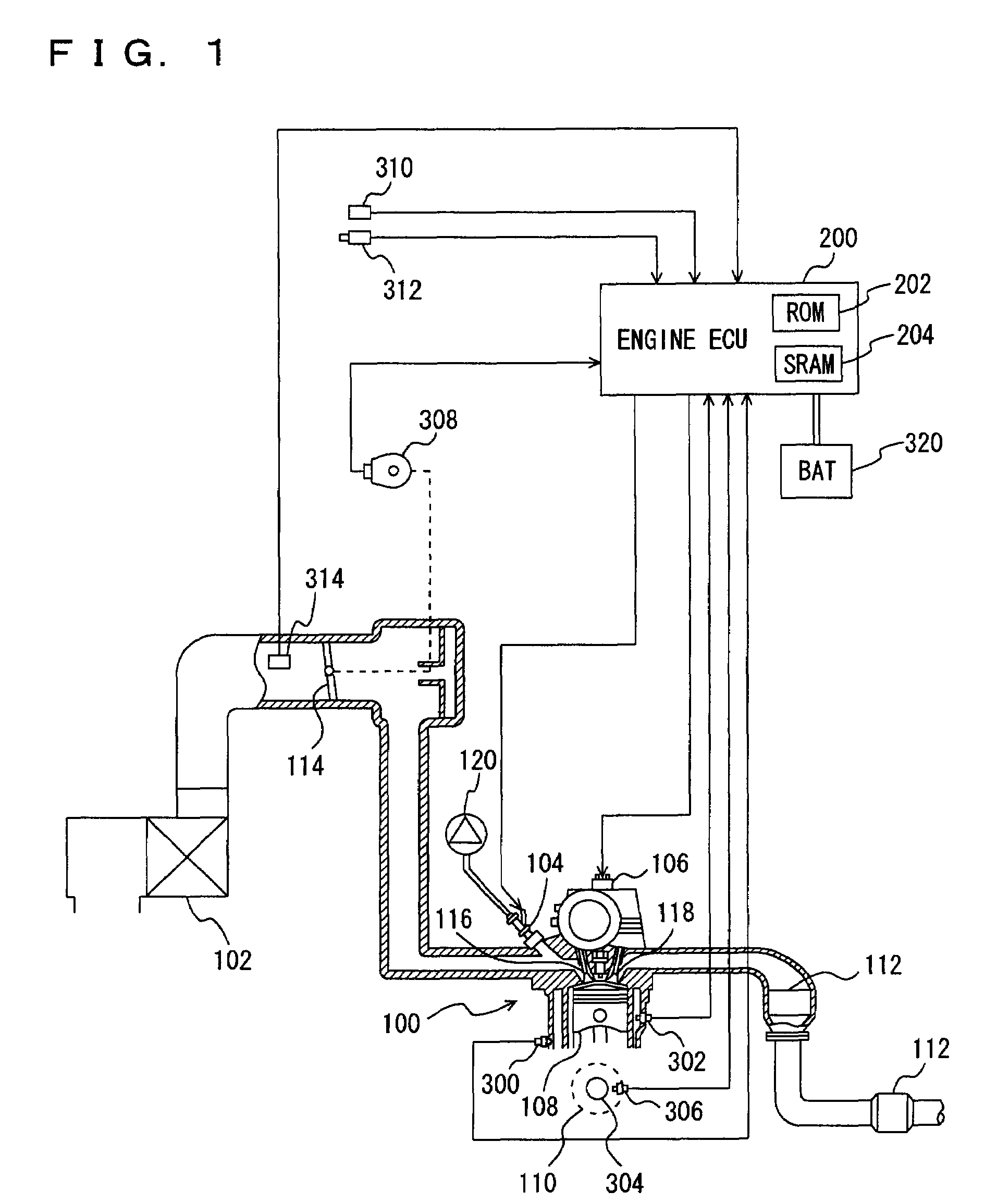[0009]An object of the present invention is to provide a device and the like for determining knocking of an internal combustion engine that can precisely determine whether knocking is present or absent.
[0011]According to the present invention, a magnitude of vibration in a first frequency band that includes a frequency of vibration due to knocking is detected, out of vibration occurring in the internal combustion engine. Thus, the magnitude of vibration particular to knocking can precisely be obtained. However, if the bandwidth of the frequency band is narrowed when detecting a waveform from the magnitude of vibration, vibration of noise components is removed. As a result, a characteristic portion of noise components (such as occurrence timing of vibration, attenuation rate and the like) is removed also from the waveform. In this case, even as to vibration that is actually due to noise components, a waveform that is similar to a waveform at the time of knocking may be detected. Therefore, the vibration at the time of knocking and the vibration due to noise components are hardly discriminated from each other based on a waveform. Accordingly, a magnitude of vibration in a second frequency band that includes the first frequency band and that is broader than the first frequency band is detected. A waveform of the vibration in the second frequency band is detected, based on the magnitude of the vibration in the second frequency band. Thus, a waveform that may include vibration due to noise components can be detected. When a magnitude greater than a predetermined threshold value is detected from the vibration in the second frequency band, it can be regarded that knocking is likely to have occurred. Conversely, when a magnitude greater than a threshold value is not detected from the vibration in the second frequency band, it can be regarded that knocking is less likely to have occurred. Accordingly, when it is determined that the magnitude greater than the threshold value is detected from the vibration in the second frequency band, whether or not knocking has occurred is determined based on a result of comparison between the waveform detected from the magnitude of the vibration in the second frequency band and a waveform model and on the magnitude of the vibration in the first frequency band. On the other hand, when it is determined that the magnitude greater than the threshold value is not detected from the vibration in the second frequency band, it is determined that knocking has not occurred. Thus, when it can be regarded that knocking is likely to have occurred, whether or not knocking has occurred can precisely be determined fully considering the characteristics of both knocking and noise. This can suppress erroneous determination that knocking has occurred while it has not. As a result, a device for determining knocking of an internal combustion engine that can precisely determine whether knocking is present or absent can be provided.
[0013]According to the present invention, whether or not a magnitude greater than the predetermined threshold value is detected from the vibration in the second frequency band in a first interval of crank angle out of the first interval of crank angle and a second interval of crank angle, in which a magnitude of the vibration that is vibration in the second frequency band and that is due to knocking is smaller than in the first interval, is determined. Knocking has such a characteristic that it occurs at approximately the same crank angle, and that the magnitude of vibration due to knocking attenuates after the occurrence of knocking. Therefore, when the magnitude greater than the threshold value is detected from the vibration in the second frequency band in the first interval, it can be regarded that knocking is likely to have occurred. Conversely, when the magnitude greater than the threshold value is not detected from the vibration in the second frequency band in the first interval, it can be regarded that knocking is less likely to have occurred. Accordingly, when it is determined that the magnitude greater than the threshold value is detected from the vibration in the second frequency band in the first interval, whether or not knocking has occurred is determined based on a result of comparison between the waveform detected from the magnitude of the vibration in the second frequency band and the waveform model and on the magnitude of the vibration in the first frequency band. On the other hand, when it is determined that the magnitude greater than the predetermined threshold value is not detected from the vibration in the second frequency band in the first interval, it is determined that knocking has not occurred. Thus, when it can be regarded that knocking is likely to have occurred, whether or not knocking has occurred can precisely be determined fully considering the characteristics of both knocking and noise. This can suppress erroneous determination that knocking has occurred while it has not.
[0019]According to the present invention, the threshold value is calculated as a product of an average value of predetermined number of magnitudes selected by placing higher priority on smaller magnitudes and a predetermined coefficient. Thus, the threshold value can be calculated based on the magnitude that may not be due to knocking or noise and that may be the mechanical vibration of the internal combustion engine itself Accordingly, the threshold value suitable for individual internal combustion engine can be obtained. By comparing such a threshold value and the detected magnitude with each other, the possibility that knocking have occurred can precisely be determined.
 Login to View More
Login to View More  Login to View More
Login to View More 


